Building a bridge between nursing and technology.
At some point in our lives, we’ve all known the care, support and compassion of a nurse. They’re there for us when we’re most in need and vulnerable. And although health care is continuously evolving, a nurse’s responsibility for patient care remains constant. That’s why it’s essential in IT that we empower caregivers with the best tools and resources to do their jobs.
At Houston Methodist, the IT and nursing partnership helps shape technical decisions and project planning, benefiting our patients and clinicians.
“Nurses are pulled in a million different directions, so they need technology that makes work easier and reduces complexities,” said Kerrie Guerrero, Houston Methodist The Woodlands vice president and chief nursing officer. “We’re fortunate that many of our IT partners come from the nursing world, so they understand our needs and help us focus on patient care.”

Focus on better patient care, more efficiencies.
Working in close partnership with clinical operations and systemwide leadership, IT teams consistently review our catalog of nursing applications, tools and systems to ensure they meet their intended purposes and promote better patient safety and greater clinician efficiency.

“Our technology needs to be about simplifying and streamlining the non-clinical responsibilities of our nurses,” said Janet Leatherwood, chief nursing officer at Houston Methodist Sugar Land. “In Epic alone, there are hundreds of lines of potential documentation in our various flowsheets. This record-keeping is essential, but it shouldn’t be a distraction.”
Using nursing efficiency assessment tools, we’re also evaluating our documentation workflows, looking for opportunities to improve our process and education – from a system, entity, unit and individual level. These tools provide valuable usage data, helping to identify areas in our workflows that cause nurses to spend more time documenting. Nursing leadership can then review this information for future system improvements.
“The patient acuity scoring tool will allow nurses to quantify their workload based on accurate patient data, which should enable more equitable nursing assignments,” said Katie Reed, MSN, RN, an educator at Houston Methodist Hospital Walter Tower 14.
“Improving nursing workloads allows nurses to have more time to focus on patient safety and quality of care. And with more manageable assignments, nurses will feel greater satisfaction with their work environment and may be more likely to remain with Houston Methodist.”

CNIO. A tech advocate for clinical staff.
Nursing staff and leadership have a special partnership with IT that drives improvements and positive changes. This connection will grow even stronger when a new chief nursing informatics officer (CNIO) role becomes part of the IT senior leadership team. Filling this position will provide another voice for nurses and other clinicians.
“We recognize the important dimension nursing brings to health care and the intrinsic role of technology in patient care,” said Ken Letkeman, Houston Methodist chief information officer.
“Bringing better focus and attention to this relationship is essential to our successes moving forward. With our new CNIO, we hope to bring a strong voice and advocate for nursing informatics to our planning and operations.”
The CNIO will partner with clinical operations to help shape nursing efforts through a better understanding of workflows, barriers nurses face and opportunities for the best interaction.
Always looking for opportunities to learn and grow.
Nurses represent the heart and soul of our hospitals. Their care, compassion and concern literally affect peoples’ lives. Working together, we’re uncovering new opportunities to improve patient care by leveraging technology. This bridge between nursing and IT ensures tools are available to continue enabling unparalleled patient care.
